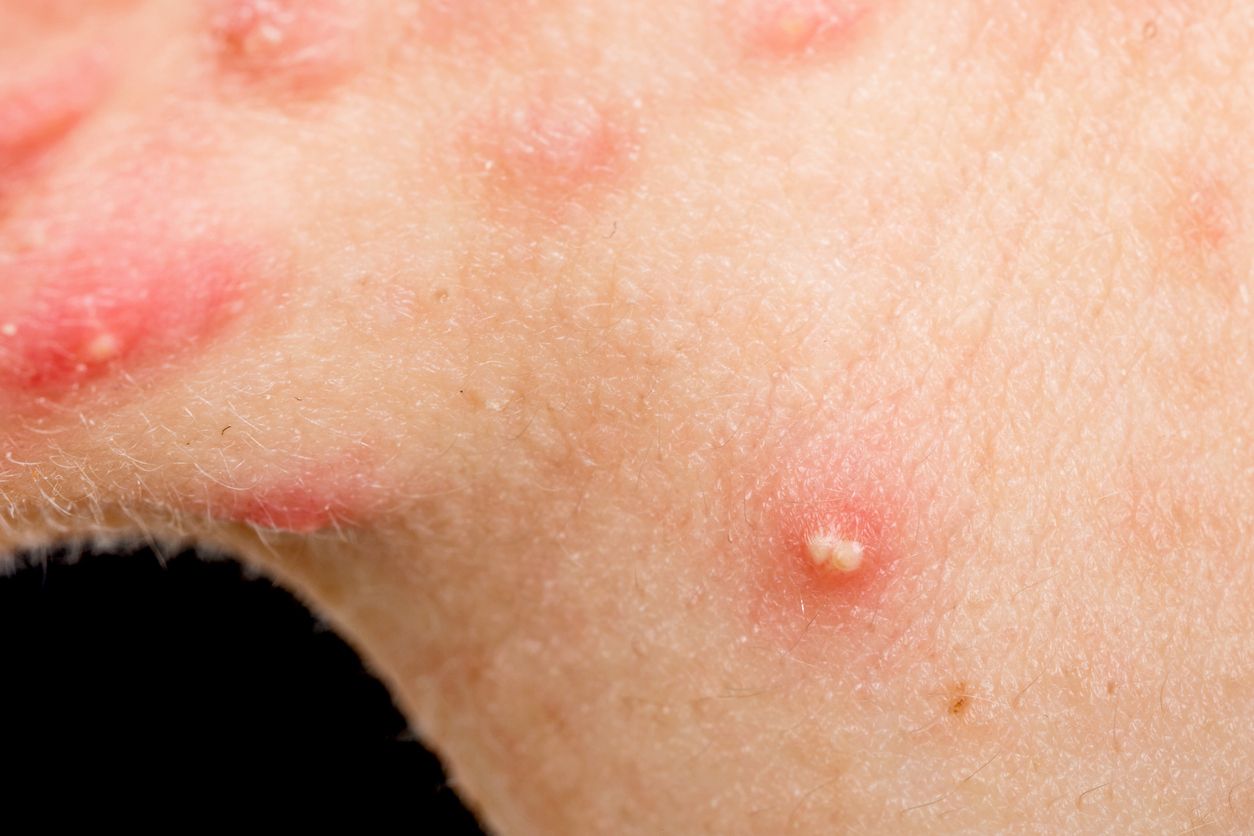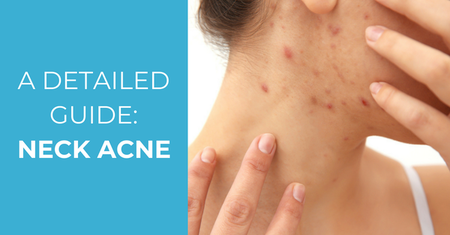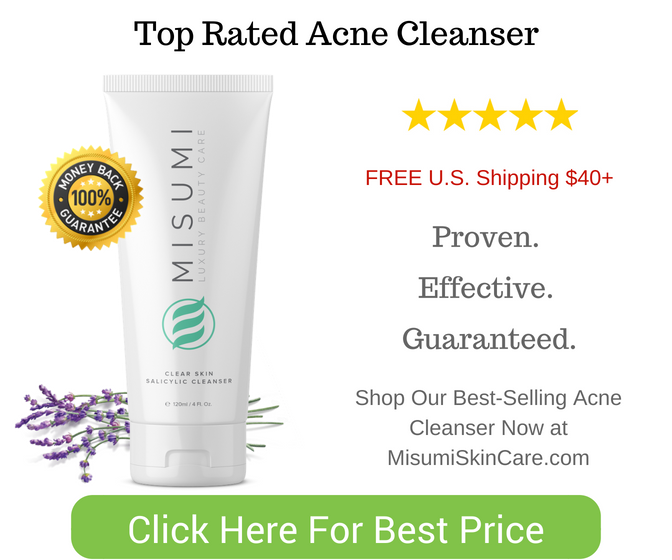Contents
Neck pimples represent a type of body acne and are very common among young adults of both genders. Typically, women are more prone to developing neck pimples than men due to various issues as you will see in the “causes” section of the article.
Neck Acne
Neck blemishes can turn out to be any type including whiteheads, blackheads, papules, pustules, cysts, etc. however, in contrast to facial acne, it’s much harder to treat.
This is primarily due to the skin on the back of the neck being a lot thicker, much like the skin on the back and chest. Also, the sebaceous glands of the neck region produce a lot more oil, which increases the chances of pore-clogging. Finally, hair follicles in this area are more expressed, meaning that there is a higher chance of cysts developing in an ingrown hair region.
It’s important to note that the frontal part of the neck (the area below the chin) isn’t the same as the back. The skin is a lot more delicate, which makes a difference during treatment.
Cystic Neck Acne
Out of the 80% of people who suffer from bad pimples and severe acne, about 1 in 7 get acne on the neck, but those aren’t necessarily a big problem to deal with – more like an annoyance than anything. For instance, whiteheads and blackheads on the frontal area of the neck can be caused by the accumulation of dead skin cells or excess oil, and simply washing your neck twice a day can help reduce the number of pimples very quickly.

However, when it comes to cystic acne, things get very different. People with brown skin tones tend to escape neck zits as teenagers, but develop them when becoming young adults.
As paradoxical as it sounds, this is largely connected to the skin on the back of the neck being “too healthy”. It grows over pores before they get a chance to drain, resulting in the immune system attacking the trapped bacteria causing inflammation, which eventually leads to the formation of painful cysts.
People of non-Hispanic origin can also get cystic neck spots, which, in most cases, is caused by blocked hair follicles.
When bacteria get trapped in a pore with a blocked hair follicle, it creates a hospitable environment for them to breed. As the number of bacteria grows, the immune system tries to eliminate it, causing inflammation and redness and ultimately leading to cystic acne formation. Cystic acne is generally located very deep inside the skin, causes a lot of pain and discomfort, is very persistent (they keep coming back), and can take weeks to heal completely.
Neck outbreaks are primarily caused by excess sebum oil, dead skin cells, and acne-causing bacteria. However, there may be other, less obvious causes that are worth mentioning. Pimples are a very common skin condition.
1. Hormones
Hormonal blemishes can be caused by menopause, breastfeeding, and digestive problems, but it is most common during puberty and pregnancy but it can also be caused by fatty acids.
As both girls and boys approach adolescence, the level of Androgens (the hormones that stimulate sexual organs) increases, while simultaneously causing sebaceous glands to produce oil like crazy, resulting in breakouts. The use of oral contraceptives can also cause incorrect sebaceous gland functioning, which can lead to breakouts.
In some cases of pregnancy, low levels of Androgen can cause the acne on the neck to worsen substantially. Finally, irregular cycles can lead to hormonal changes causing neck pimples. Among everything else, hormonal acne can be treated via natural methods and diet.
2. Lactose Intolerance
A high number of dermatologists believe that pimples on the neck are linked to lactose intolerance, however, there is no concrete proof. If dairy products are a common part of your diet have any trouble with digesting dairy products, try eliminating them for a couple of weeks to see if the acne gets better.
3. Stress
People with blemish-prone skin are more likely to break out when faced with increasingly stressful situations over an extended period of time. Exam periods, highly intense work and personal problems are a few examples of situations that can worsen.
4. Cosmetics
Many cosmetic products contain comedogenic ingredients, which can result in pimple/acne formation. The most common ingredients that result in pore-clogging are Lanolin (used in moisturizers), algae extract (commonly found in concealers), almond and coconut oil, cocoa butter, benzaldehyde (used as a fragrance), Isopropyl Palmitate (used in tinted moisturizers), Lauroyl Lysine (found in loose powders), Lauric Acid, Sodium Chloride (table salt) and Shea butter.
5. Oily Hair
Oily hair, especially when it’s long, can clog pores when mashing against the skin of the neck. Keep your hair clean and tie it behind your back to stop irritating the affected areas. Common sites for acne are the face, chest, shoulders, neck, and back. This is because these are the sites of oil glands. It is important to clean your skin regularly.
6. Hair Products
Many hair products contain oil or wax, which blocks the skin’s surface and does not allow the skin to breathe, leading to neck blemishes.
7. Skin Irritators
Constantly touching and rubbing your neck with your hands can easily irritate the skin and transfer bacteria. Avoid touching your neck with hands, fingers, and any other potential irritators. Dry skin especially, failing to wash your skin properly can also lead to clogged pores and pimples which will cause your acne to get worse.
8. Clothing
Scarves, shawls, and any clothes with high collars can cause breakouts in the neck area. Those limit the amount of oxygen around the skin and create a favorable environment for bacteria to breed. The heat caused by scars and collars causes the skin to become moist, which is only causing further issues. Try to minimize wearing scarves and turtlenecks as much as possible during the day, and wash them regularly.
9. Wrong Shaving
Wrong shaving techniques lead to ingrown hair, can cause highly influence breakouts around the neck area and worsen acne Always try to use high-quality, softening shaving gels and creams, and a new razor every time you shave. If a new razor isn’t available, dip the old one in antibacterial solutions to eliminate bacteria before shaving.
10. Bed Sheets
Like in the case of the face, changing your pillowcases and bed sheets at least once every 10-14 days (ideally, change twice in 7-10 days) is a must to avoid frequent breakouts. If you have an oily skin type, you’ll need to change the sheets even more frequently, since the excess oil gets on the pillowcases very fast and traps bacteria inside, which then easily transfers to your neck while you sleep.
11. Sports Gear
Some types of sports gear, particularly collars, straps, and towels that are constantly rubbing against the back of the neck can cause outbreaks. Try to loosen the straps to allow the skin to breathe and always shower immediately after each sporting event to minimize the irritation.
Combating neck blemishes and acne treatment can be very easy, or very difficult depending on the cause and pimple type. Many types of pimples can be dealt with by simply eliminating the cause(s) mentioned above and following simple neck hygiene steps:
- Wash your neck every morning and evening using antibacterial soap.
- Apply a non-comedogenic, alcohol-free cleanser and gently rub it over the infected areas.
- Use your fingertips when applying the cleanser. Washcloths, sponges, or any other materials can irritate the skin and make the pimples worse.
- Rinse your neck well and pat dry with a paper towel to avoid irritation.
If the hygiene alone isn’t enough, try using common over-the-counter methods that contain ingredients that are beneficial for your skin type and will help treat acne. If you have more severe acne you should get it treated by a doctor.
Many treatments (Medications like acne products) recommended to treat acne can make your skin more sensitive to light, so exposure can increase your risk of skin cancer. Those with sensitive skin especially should be careful as some treatments can aggravate acne instead of helping to soothe skin.
For instance, benzoyl peroxide, salicylic acid, sulfur-containing products, and glycolic acid are great when combating mild to moderate breakouts, but affect various skin types differently and are useful acne products.
Benzoyl peroxide is an anti-inflammatory and is also antibacterial and Benzoyl Peroxide is often found in over-the-counter cleansers and medication, it helps to dry up oil alpha hydroxy acids. including glycolic acid.
Benzoyl peroxide is one of four drugs that has proven to be effective for the treatment of acne. Remember to be careful with benzoyl peroxide fabric as it can bleach any fabric.
Another one of the four drugs that have been proven to be an effective treatment of acne is salicylic acid. Salicylic acid is available in creams, lotions, and pads, Salicylic acid also dries out your skin and can cause it to slowly peel.
On the other hand, cystic acne will be much harder to get rid of with OTC methods, mainly because the cysts on the neck are located deep inside the skin, which is a lot thicker compared to the skin on the face. If you have a mild breakout, it may be stopped with tried and true homemade remedies. Here are a few of the best-working and easiest ones:
Lemon juice – Freshly squeezed lemon juice contains a lot of Vitamin C. Leave the juice for about 10 minutes and wash it off with cold water, pat dry with a paper towel.

Manuka Honey – Manuka Honey has tons of antibacterial and anti-inflammatory properties. Manuka Honey masks can be very effective against neck pimples.
Sea salt scrub with Aloe Vera and green tea – Both sea salt and Aloe Vera are excellent acne-combatants thanks to their healing and nourishing properties. Brew a cup of hot green tea with the help of a tea bag or tea leaves. Let it sit for 5 minutes. Remove the bag (or leaves) and add 1 teaspoon of sea salt.

Mix until it fully dissolves. Add a tablespoon of (preferably freshly squeezed) Aloe Vera juice and stir well. Apply the mixture over affected areas with the help of a clean washcloth. Leave it on for around 5 minutes and rinse with water. Pat dry with paper towels.
Depending on your individual case, unique chemistry, and skin type, OTC methods containing potent levels of benzoyl peroxide and salicylic acid, with combinations of various other aggressive chemicals and calming natural ingredients, can also be highly effective. One such product is The Acne Regimen, found on Amazon. If you decide to give it a try, make sure to wear sunscreen when being outside to avoid getting permanent skin marks.
Here is a great video that will tell you more about the product:
In case of moderate to severe cystic acne, you’ll need stronger stuff. Oral antibiotics, Tretinoin, Accutane, laser removal therapies, Blue light acne removal procedures are all applicable choices. However, many of these cures can have considerable side effects on your body, which is very dangerous. Make sure to consult a dermatologist or other qualified professional before committing to any of these treatments.
Have you faced neck acne before? What did you do to get rid of it? What was the cause? How did you find out? Share your thoughts and experience with everyone in the comments!





